

AUTOMOBILE AGE
The production of automobiles in the United States began in 1895, and for the next 15 years, several models were found. By 1912, there were 600,000 vehicles on the road, and Manning already has its share. After interchangeable parts were introduced by Henry Ford in 1913, automobile production increased greatly, and it seemed like everyone was demanding his own car. These cars needed to be "broken in", and for the first 1,000 miles, couldn't be driven over 20 miles an hour.
Herman Gotch was the first to enter the automobile business in Manning. He began selling motor cars in 1908 while working for Tom D. Parkhouse; after five years, he went into business for himself. His shop was located at 814 Third Street, which had been built in 1911 by T.W. Stuhr and his sons Albert and Ed. Albert sold International machinery and automobiles from the building for two years before selling the business to Gotch. This building now houses the McMahon Feed and Seed Store.
Gotch, who sold and serviced Hudson and Essex cars, moved to 413 Main Street several years later. Sales included Hudson coaches at $1345 and seven-passenger sedans for $1895, as advertised in 1925.
After Gotch discontinued the business early in World War II, the building was used as storage for Priebe & Sons.
In 1946, Manning Motor owner Arthur Bock bought the brick building, staying there until a new building was erected at 503 Main. The former Gotch Garage is now the home of Schulte Barber Shop.

F. D. ROSS & CO.
The F.D. Ross & Co. garage business had its origins in September, 1914. Fred Ross began handling Ford cars in the Peter Ohrt building at 715 Third Street. After two years of business, he sold half interest to Jack Bald, and in 1918, they sold one-third of their holdings to Emil Albert. The following year, the F.D. Ross & Co. built a 90 by 150 foot brick building at the corner of Center and Third Streets, which included a full basement for storage room.
Bald sold his interest to August Ross in 1928. Ray Ross, Fred's son, joined the firm in 1932. After Fred's death in 1939, Ray, August, and Fred's widow shared the partnership.
The company was actually three separate businesses under one roof. Implements were sold under the name of Ross Implement, with two salesmen and two mechanics. Two tank wagons were kept busy, as the firm was the distributor for the Sinclair Oil Company. The garage business included three salesmen and four mechanics. These employees were in addition to the owners and bookkeepers.
For several years, the firm sponsored "Ford Days", with a new car given to the lucky winner.
F.D. Ross & Co. was sold to N & B Motors in 1959, who in turn sold the firm to Dwight "Parky" Parkinson. He discontinued the business after about one year. The building is now owned by the HMC Corporation and houses the Plastico manufacturing company.
FRAHM GARAGE
Herman Frahm opened his garage in 1919, after completing a course in the National Automobile School at Kansas City, Missouri. He purchased the building at 215 Main Street from Tom Parkhouse, and his brother John soon entered the firm, which became known as the Frahm Brothers Garage. They sold the famous Studebaker, and were the first to introduce the free wheeling, Chrysler and Plymouth cars to Manning in the 1920's. They also handled accessories, Goodrich tires, and had a repair shop.
The brothers dissolved their partnership in 1945, and Herman continued to operate the Frahm Motor Co. until 1960.
Fred Petersen entered the tire business in 1922, first locating at 413 Main Street. He soon added Willard batteries, and the business grew so fast that within a year he sought a larger building. He moved to 715 Third Street in 1923, and by 1930 was employing from seven to nine men.
Petersen began handling Goodyear tires in
Continued from page 209
1926, and in 1929 took the franchise for Chevrolet Motor vehicles for this territory. The new cars, according to a report in the 1931 Monitor, "is a line that includes all desired and basic changes that have been made in the motor car industry, and is famous for its wonderful motor."
In the 1930's, Petersen moved to the northwest corner of Highway 141 and Main Streets. After the building was destroyed in a fire in 1943, Petersen operated from two locations; the batteries, tire repairs, and some mechanical work was done at the corner of Third and Elm Street (now J & S Feed office), and the body repairs and other mechanical work was done at the former service station at the east edge of Manning.
In 1945, Petersen moved into a new 50 by 100 foot building at the south end of Main Street, which was erected by Chris Pfoltner. Petersen, who had switched from Chevrolets to the Dodge and Plymouth lines in 1934, used the north half of the building for the garage and the south half for a Standard gas station.
In 1957, Petersen sold the garage to his son Warren Petersen and James Albert, who continued as partners until 1962. Albert ran the business alone until it closed in 1967.
John Ostermeyer and J.J. Schroeder also had garages in the 1920's and 1930's. Ostermeyer came to Manning about 1921, first having a repair shop and then forming a partnership with Schroeder.
Ostermeyer later went into business for himself, handling the Pontiac and Oakland cars, Osden Liquid Gas and oils and having a repair shop at 421 Main Street.
Schroeder had a garage and repair shop at 503 Main Street, where he offered the Oldsmobile automobile, U.S. Tires, Crosley radios and accessories.

MANNING MOTOR COMPANY
The Manning Motor Company originated in 1934, when Arthur and Lawrence Bock purchased the Chevrolet agency from Fred Petersen. They were first located in Petersen's old building at 715 Third Street which has since been replaced by city hall.
In 1935, the firm moved to 419 Main Street the building now occupied by the Struve Motor Company. Another move was made in 1947, to the former Gotch Garage at 413 Main Street. This building is now occupied by the Schulte Barber Shop.
In 1948, the company erected a new brick building at 503 Main Street. In the early 1960's, the business expanded into the building adjoining it to the south, which had at various times housed a livery barn, blacksmith shop, hotel, and hatcheries.
Manning Motor again expanded in 1979, when the company purchased the former Klean Klose business across the street to the north. The building was razed, and the site was made into an Manning Motor Co. open display area. In December, 1979, Manning Motor purchased the former tavern to its west, which has now been made into the firm's parts room. A dust-proof paint shop was also added at this time.
George Fischer began employment with A/W. Bock in 1935, and his brother Eddie Fischer joined the work force in 1937. In 1959, the firm was incorporated and stock was sold to the Fischer brothers. January 1, 1966, they became the sole owners and have since that time enjoyed a good relationship with the people of the Manning community and also with their employees. As of April, 1981, Manning Motor had a work force of 11.

STRUVE MOTOR COMPANY
John J. Struve and Merlin E. Struve established the Struve Motor Company in 1947 at 419 Main Street. They originally handled the Kaiser-Frazer and Willys lines. Two years later, they added the Buick Agency and discontinued the Kaiser-Frazer. The Willys were discontinued in 1958.
John J. died in 1961. Merlin, his son, has continued the business in the same location and in the same building, which he owns.
Merlin, born in 1915, is married to Elaine Karsten, and they have a daughter; Mrs. Rober (Frances) Haack. Merlin is a member of the Presbyterian Church, Chamber of Commerce, and American Legion, having served 37 months it the Air Force in World War II. He was a member of the Manning School Board for 13 years.
Continued from page 210
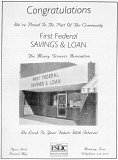
Continued from page 211
SERVICE STATIONS
During the first years of the automobile age, most gasoline, oil, tires, and other services were handled through the garages which sold the cars. In the 1920s, specialized tire and battery stores began to appear, and these later evolved into what we know as service stations.
The 1931 Manning business directory lists three stations: The Diamond Service Station at 424 Main Street, operated by Herman Behrens, and the Standard Oil Station, which had two locations, one at the corner of Main and Sixth, managed by Leo Kerwin, and the other at the corner of Main and Second, managed by Bob Zerwas.
As automobile travel increased during the next ten years, the number of service stations also grew. The owners and operators of the stations changed about as rapidly as the models of cars they service.
By 1945, Manning had a number of stations, with a tank wagon delivery service connected to several. Included were: Merle Stoelk's Standard Service, with the tank wagon run by F.E. Doughtery, then by Ed Erps, and then by Kelly Musfeldt; Ed Groppe's Skelly Service; the Manning Oil Company; Emil Jansen's D-X, with Jake Kuker running the tank wagon; Herman Behren's Home Oil Company; and Pete Kuhl's Diamond Station, located in the "Twin Gables" building constructed in 1937.
In 1946, Elroy Schrum had the Deep Rock station at the west edge of town on Highway 141, with Ralph Monson running the tank wagon.
Five of these stations continue today, some under new dealerships, all with new owners.
RIX BROS. STANDARD

The Standard Station, at the northeast corner of Highway 141 and Main Streets, is one of the oldest service stations in Manning. Durings its 50 year history, the owners have changed, the original building replaced, and it was switched to a Conoco franchise for a short while, but today it is continued as a dealer for Amoco's Standard products.
Between 1930 and 1945, the tiny station on the centrally located corner lot was operated by a number of people, including Warren Bartels, Harry Schade and Merle Stoelk.
Another Standard station was found at the corner of Main and Second Streets. A quonsat-type building was erected by Emil Jansen, and later moved to the farm at the south of Willow Creek Park. In 1949, Dr. J.L. Loucks built an apartment building on the location.
The land at the corner of Highway 141 and Main Street was originally owned by Chris Pfoltner. In 1945, he built a large building to house both a service station and garage, which were run by Fred Petersen. In 1953, Petersen sold the service station part to Ken Fogleman, while Fred's son Warren and James Albert continued the garage.
George Pfoltner purchased the land in 1960, and brothers Allen and Larry Rix took over the service station the same year. The station became known as the A & L Station, but in 1965, they changed the name to the present Rix Bros. Allen continues to operate the service station. The garage closed in 1967, and the showroom, used as a recreation center in the mid-1960's, is now the headquarters for Larry's tank wagon service. Larry took over the tank wagon from LeRoy Mundt, who had retired in 1978 after a 32 year career in the business.
The building was remodeled in 1961, when an addition was made to the south, and new restrooms, lights, and hoists were added. The building was given a new porcelain front in Amoco's new choice of colors; Amoco representatives came to Manning to inspect the red-white-gray pattern, and changed to other colors. Manning's station was, and is, the only Amoco station in the United States to have these colors.
A car wash was added in 1970.
George Pfoltner sold the land in 1976 to the Manning General Hospital, which is located across Fifth Street to the north of the station. Although it was first announced that the hospital planned to expand to the highway, those plans have been temporarily tabled.

Continued from page 212
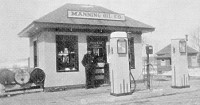
MANNING OIL COMPANY, INC.
In 1933, Darrel Davidson of Clarinda, Iowa, built the Davidson Oil Company station on the corner of 3rd & Elm street. Formerly this was the site of a miniature golf course owned by Henry Rohr, Sr. Darrell operated the station for one year. April 1, 1934, he sold the property to Larry Polking of Breda. The name of the company was then changed to The Manning Oil Company.
The price of gasoline at that time was 14 cents per gallon. Fuel oil cost 6.8 cents per gallon. Services rendered free to the public were mounting chains, washing windshields, checking tires, checking batteries, testing radiators, and free coffee.
The greatest trial the company experienced was the Nishnabotna River flood in June 1947. Flood waters carried three tanks containing thousands of gallons of fuel oil and gasoline down the river. With the help of friends, especially Ralph Monson, a competitor, the company survived. Ralph offered the use of his storage tanks and the company was able to continue operation until it could repair the flood damages.
In 1954, as the company expanded it was necessary to build the new and larger station which is still in operation. It was sold October 1, 1974, to the present owners: Donald Joens, Daryl Rowedder, and Robert Hagedorn.
It is now known as The Manning Oil Company, Incorporated.
CLARK'S SERVICE
It was in 1937 when Lester Clark first started working in a service station. Then he decided to work with his brother Shirley, who owned and operated a salvage yard just east of town in the vicinity of Willow Creek Park.
Lester started in the oil business in 1946, operating a station on the east edge of Manning. He moved to the corner of West Street and Highway 141 in 1949, and was in partnership with Ralph Monson until June, 1955. Lester then became the sole owner of the station and a jobber for the Frontier Refining Company of Denver, Colorado, selling their petroleum products.
Also in 1955, Lester married Caroline Stammer Keane, and they built their home at 516 West Street.
During their years in business, the Clarks saw many changes, such as the prices of products, including gasoline. Also, the working day was longer than eight hours, with Sundays and holidays considered working days, too. The customer took time to visit a bit with neighbors and friends after their business transactions, and the small station office was quite a meeting place. Often a game of cards was in order.
In April, 1976, the Clarks had an auction, selling all merchandise on hand, as well as equipment and tools.
At that time, the building was leased to Clarence Edmunds, who continues to manage a complete auto repair shop and service station. He continues to give this community the best in service with high quality merchandise.
Death came to Lester Clark at age 74 in July, 1978.
ROSTERMUNDT'S DEEP ROCK STATION
In 1940, John Rostermundt and his father Julius built a service station at the east edge of Manning. The station also included a welding shop, where farm machinery and auto repairs were done.
John's ability to turn old automobile bodies into running gears for wagons was a welcome skill to area farmers, who could not get new equipment during the war years.
The station handled Deep Rock products, which were then being sold at 18 cents a gallon for gasoline, 25 cents for a quart of oil, and 15 cents for bulk oil.
In 1945, Rostermundt was advised to move his family to a drier climate for medical reasons. The station was then taken over by Lester Clark.
The station was later torn down, and the lot is now used as a storage area for a local feed company.
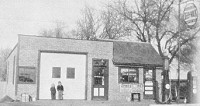
Continued from page 213
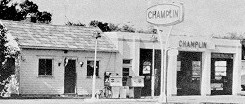
STEIN'S OIL & SERVICE
The Champlin station on the east edge of Manning was built in 1936 by Herman Behrens, who operated it as a Texaco station. Behrens sold the station in 1949 to Ralph Grundmeier.
Champlin Petroleum Company from Oklahoma purchased the station from the Texaco company in 1958, giving Manning the opportunity to use Champlin petroleum products. Ralph Monson, Manning, had the tankwagon service, providing the farmers and local customers with gasoline, diesel fuel, and heating oil.
In 1962, Grundmeier sold the business to Jerry Johnson of Manning, and it was then called Jerry's Oil & Service. Monson continued to run the tankwagon service.
The station was purchased by Lynn Stein of Manning in April, 1975, and the name was then changed to Stein's Oil & Service. Monson sold his tankwagon service to Stein's Oil & Service in January, 1976, and Lynn has continued this service to the present time.
IRLBECK OIL COMPANY
In 1942, Jake Kuker started the Phillips 66 tankwagon service, which was known as Kuker Oil Co. The same year, Emil Jansen started the Phillips 66 Station with his brother, Andy Jansen. The station was located on Highway 141, where the car wash is located today.
In 1954, Jake Kuker sold the tankwagon to Norman Kuker, who kept the same trade name. Norm expanded to the "on the farm" tire repairs in the early 60's.
Norm sold out to Raymond Peters of Westside in 1962. Emil Jansen retired the same year and sold the station to Walt "Butch" Muhlberg.
In 1967, Ray Peters sold the station and tankwagon to Merlyn Irlbeck, who renamed it the Irlbeck Oil Co. He moved the station and bulk plant in 1974, one quarter mile west of the original location, to its present location.
Irlbeck sold the station to Dave Rohe in 1976. Irlbeck continues the tankwagon and tire service from Rohe's 66 Station.
ROHE'S 66 SERVICE
Dave Rohe purchased the Irlbeck Oil Company July 19, 1976, and renamed it Rohe's 66 Service. The station is located west on Highway 141.
Rohe, a native of Manning, graduated from Manning High School in 1969. He then completed a one and a half year course in auto mechanics at Iowa Western Community College in Council Bluffs.
After purchasing the station, Rohe added diesel fuel and a new hoist for repair service. He now has one full time and one part time employee.
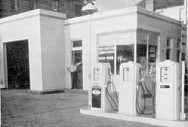
I CAN REMEMBER---
When cars were parked down the center of Main Street, during the early 1920's. North traffic was on the east side of the street, with south traffic on the other side of the parking area. This made it convenient for us farmers to unload our egg cases at the stores.
---Alice Grau
